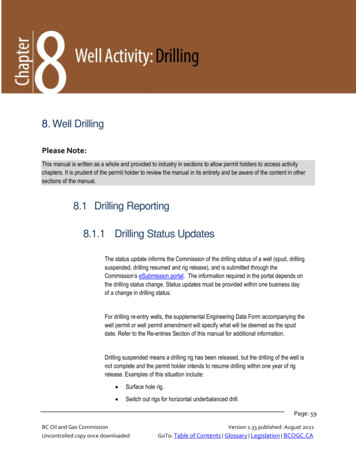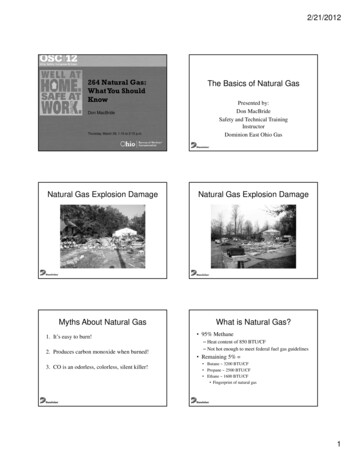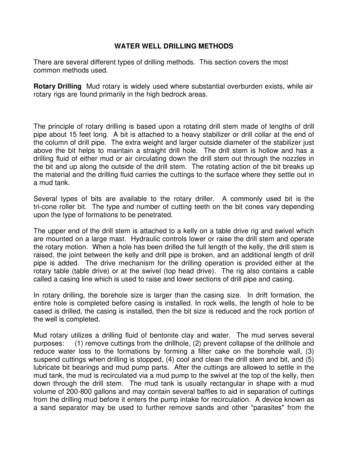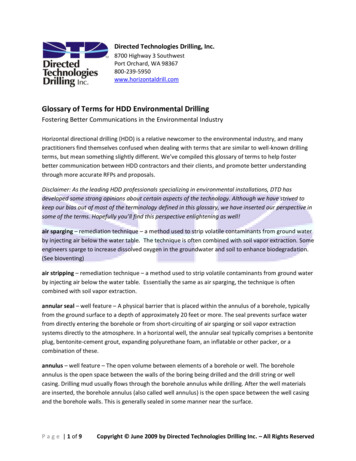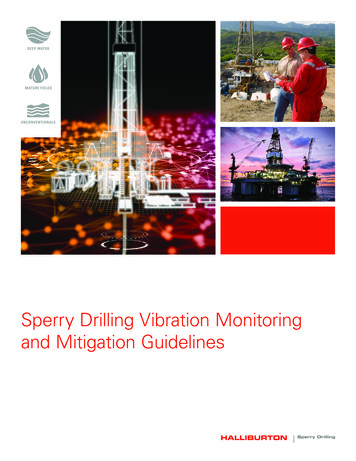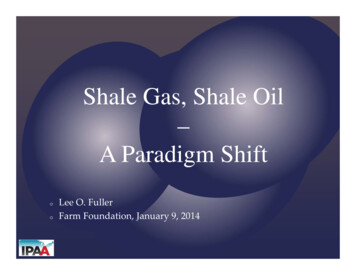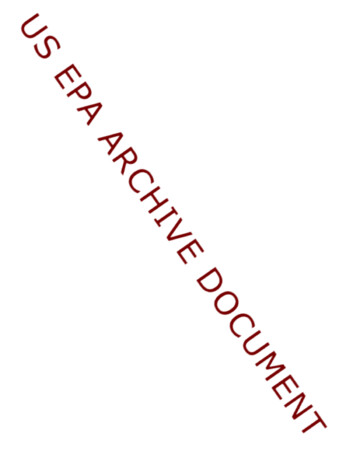
Transcription
Attachment to memorandum from James Hanlon, Director of EPA’s Office of Wastewater Management to the EPARegions titled, “Natural Gas Drilling in the Marcellus Shale under the NPDES Program”March 16, 2011Natural Gas Drilling in the Marcellus ShaleNPDES Program Frequently Asked Questions1) What is the Marcellus Shale?The Marcellus Shale is an organic rich rock that has been estimated to contain from 50 to500 trillion cubic feet of natural gas1. It was deposited in the Appalachian Basin 350million years ago as part of an ancient river delta and consists of the bottom layer of anUpper Devonian age sedimentary rock sequence. Like most shale, the Marcellus wasdeposited as extremely fine grained sediment, with small pore spaces and lowpermeability that prevents gas from easily migrating1. Often called the Marcellus BlackShale due to its color, the formation exists under much of southern New York,Pennsylvania, West Virginia, eastern Ohio, and far western Maryland. Although theshale outcrops at its namesake, Marcellus, New York, it generally lies at depths of 5,000to 9,000 feet throughout much of the area.2 The Marcellus Shale generally ranges inthickness from 50 to 200 feet.2) Why is the Marcellus Shale gas extraction suddenly important for natural gasproduction?The combination of advances in drilling and fracturing technology, the large volume ofnatural gas reserves, and its proximity to eastern cities have made the Marcellus Shale animportant resource. Although the first commercial shale gas well was drilled in NewYork in 1821, extensive drilling and extraction of natural gas from shale deposits in theUnited States did not begin until the 1980’s.3,4 Horizontal drilling techniques, that makegas extraction viable in the Marcellus Shale, did not become commercially available untilthe late 1980s.5 Fracturing techniques that are needed to economically extract gas fromimpermeable shale deposits, like the Marcellus, also recently became refined.6 Analysisof the Marcellus formation geology suggests that areas in the north central andnortheastern regions of Pennsylvania have a high potential to produce significantamounts of gas. This area of the country has not traditionally seen extensive gas welldrilling.71Soeder, D.J., and Kappel, W.M., 2009, Water Resources and Natural Gas Production from the MarcellusShale: U.S. Geological Survey Fact Sheet 2009–3032, 6 p.2USGS, 2006, Assessment of Appalachian Basin Oil and Gas Resources: Devonian Shale-Middle andUpper Paleozoic Total Petroleum System.3Hill, D.G., etal, 2003 , Fractured Shale Gas Potential in New York, posted at:http://www.pe.tamu.edu/wattenbarger/public html/Selected ntial%20in%20new%20york.pdf4Shirley, K., 2001, Shale Gas Exciting Again, Explorer, posted at:http://www.aapg.org/explorer/2001/03mar/gas shales.cfm5Energy Information Administration, Office of Oil and Gas, U.S. Department of Energy, Drilling Sideways– A Review of Horizontal Well Technology and its Domestic Application, April, 1993.6Ground Water protection Council, 2009, Modern Shale Gas Development in the United States: A Primer,116 p., posted at: www.gwpc.org7Reference: “Drilling for Natural Gas in the Marcellus Shale Formation - Frequently Asked Questions” aswritten by the Pennsylvania Department of Environmental Protection and posted ilgas/new forms/marcellus/marcellus.htm.1
Attachment to memorandum from James Hanlon, Director of EPA’s Office of Wastewater Management to the EPARegions titled, “Natural Gas Drilling in the Marcellus Shale under the NPDES Program”March 16, 2011Figure 1: Location of Marcellus Shale83) How is extraction from the Marcellus Shale different from other natural gasextraction?Marcellus gas extraction is considered “unconventional” by the Department of Energy’sEnergy Information Administration because the gas is found within a shale formationrather than a more normal sandstone or limestone rock layer.9 Conventional gasextraction typically involves drilling through an impervious rock formation into a porousformation saturated with gas and trapped by the impervious cap rock. Conventionalextraction typically relies on the high permeability of the rock that allows gas to readilyflow to the well for production. Although horizontal wells have become more common8Milici, R.C., USGS Open File Reports 2005-1268, Assessment of Undiscovered Natural Gas Resourcesin Devonian Black Shales, Appalachian Basin, Eastern United States, 20059See tional gas.html.2
Attachment to memorandum from James Hanlon, Director of EPA’s Office of Wastewater Management to the EPARegions titled, “Natural Gas Drilling in the Marcellus Shale under the NPDES Program”March 16, 2011over time for conventional gas extraction, wells are more typically relatively straight andvertical.Unconventional gas extraction includes: deep gas (greater than 15,000 feet), tight gas,shale gas, coal bed methane, gas from geopressurized zones, and methane hydrates. Liketight gas which is extracted from sandstone and limestone deposits that have a lowpermeability, shale gas extraction requires techniques such as fracturing and horizontaldrilling that are less commonly used in conventional extraction. Horizontal drilling iscommonly used in shale gas extraction as a means to increase potential production.Horizontal drilling results in a well extending through a much larger portion of the shale;thereby increasing the area from which a well can produce and the amount of gasproduced.In addition to greater use of horizontal drilling, operators make extensive use of hydraulicfracturing as a means to economically produce gas from deposits with low permeability,such as the Marcellus Shale. Hydraulic fracturing requires drillers to pump largeamounts of water mixed with sand or other proppants into the shale formation under highpressure (approximately 10,000 psi) to fracture the shale formation adjacent to thewellbore and to create paths that connect the gas to the well. This allows the natural gasto flow freely up the well for compression, transmission, and sale. Once the hydraulicfracturing process is completed and the wellbore pressure is released, approximately onethird of the water flows out of the well11. That hydraulic fracturing flowback water(HFFW) must be treated to remove chemicals and minerals.1 Horizontal wells in theMarcellus Shale require 3 to 5 million gallons for hydraulic fracturing, whereasconventional wells of a similar depth required approximately 1 million gallons of water.10The greater quantity of water used for fracturing in shale gas wells is due in part to theextended reach of horizontal wells in addition to the amount of fracturing required toextract gas from a rock that has low permeability11.10Gaudlip, A.W., et. al., 2008, Marcellus Shale Water Management Challenges in Pennsylvania, SPE11989811University of Maryland, Reconciling Shale Gas Development with Environmental Protection,Landowner Rights, and Local Community Needs, Schools of Public Policy, July, 2010.3
Attachment to memorandum from James Hanlon, Director of EPA’s Office of Wastewater Management to the EPARegions titled, “Natural Gas Drilling in the Marcellus Shale under the NPDES Program”March 16, 2011Figure 2: Example of a Horizontal Well14) How many wells could be expected at a Marcellus gas extraction site?The number of wells drilled at a site is highly variable and is dependent on local drillingactivity, recycling practices of operators, state regulations on well spacing, and localordinances, among other factors. In general, 1 to 8 wells can be placed on a well pad. Asite is expected to consist of only one well pad. Since each well will require numeroustrucks to haul away HFFW, a treatment facility (Publicly Owned Treatment Works(POTW) or Centralized Waste Treatment facility (CWT)) would be expected to receive anumber of truck loads from a single site.5) How similar is the Marcellus Shale to other shale deposits where natural gas iscurrently extracted?Major shale deposits currently being developed in the United States include the Antrim,Barnett, Fayetteville, Haynesville, Marcellus, and Woodford Shale. Those shale depositsall have the common characteristic of low porosity and permeability. Extraction almostuniversally requires horizontal drilling combined with extensive hydraulic fracturing.There are some differences in depth, aerial extent, gas content, and thickness thatdistinguish between the different shale deposits. A comparison follows in Table 1. Gas4
Attachment to memorandum from James Hanlon, Director of EPA’s Office of Wastewater Management to the EPARegions titled, “Natural Gas Drilling in the Marcellus Shale under the NPDES Program”March 16, 2011extraction activities at all of those shale deposits will present the same challenges forwaste disposal.Figure 3: Shale Gas Plays in the United States12Table 1: Comparison of Data for the Gas Shales in the United States12Gas ShaleEstimatedDepth (ft)Net ThicknessBasinBasin -22012Gas 0-300Arthur, J., et.al., 2008, An Overview of Modern Shale Gas Development in the United States, ALLConsulting, 21 p., posted at: rviewFINAL.pdf5
Attachment to memorandum from James Hanlon, Director of EPA’s Office of Wastewater Management to the EPARegions titled, “Natural Gas Drilling in the Marcellus Shale under the NPDES Program”March 16, 20116) Does the Clean Water Act apply to discharges from Marcellus Shale Drillingoperations?Yes. Natural gas drilling can result in discharges to surface waters. The discharge of thiswater is subject to requirements under the Clean Water Act (CWA).The CWA prohibits the discharge of pollutants by point sources into waters of the UnitedStates, except in compliance with certain provisions of the CWA, including section 402.33 U.S.C. 1311(a). Section 402 of the CWA establishes the National Pollutant DischargeElimination System (“NPDES”) program, under which EPA, or an authorized stateagency, may issue a permit allowing the discharge of pollutants into waters of the U.S.33 U.S.C. 1342(a). When developing effluent limitations for an NPDES permit, a permitwriter must consider limits based on both the technology available to control thepollutants (i.e., technology-based effluent limits) and limits that are protective of thewater quality standards of the receiving water (i.e., water quality-based effluent limits).CWA section 301, 33 U.S.C. § 1311; 40 CFR 125.3(a). The technology-basedrequirements for direct discharges from oil and gas extraction facilities into surfacewaters are found in 40 Code of Federal Regulations (CFR) Part 435 (see question7,below).In addition to direct discharges, wastewaters may be indirectly discharged intowaters of the U.S. through sewer systems connected to publicly owned treatment works(POTW) that discharge directly to waters of the U.S. or by being introduced by truck orrail into a POTW that discharges directly. EPA regulations set standards for thepretreatment of wastewater introduced to a POTW including prohibiting introduction ofwastes that interferes with, passes through or are otherwise incompatible with POTWoperations. 33 U.S.C. § 1317(b)(1). EPA has developed other nationally applicablepretreatment standards under section 307(b) in its General Pretreatment Regulations forExisting and New Sources of Pollution (Pretreatment Regulations) at 40 C.F.R. Part 403.These pretreatment standards are applicable to any user of a POTW, defined as a sourceof an indirect discharge. 40 C.F.R. 403.3(h). These national pretreatment standardsinclude: 1) a general prohibition and 2) specific prohibitions. 40 C.F.R. 403.5.(a)(1) and(b). The general prohibition prohibits any user of a POTW to introduce a pollutant intothe POTW that will cause pass through or interference. The regulations define both passthrough and interference. Section 307(d) of the Act prohibits discharge in violation ofany pretreatment standard. 33 U.S.C. § 1317(d). See questions 10 and11, below, foradditional information on pretreatment requirements.Wastewater may also be disposed of at centralized waste treatment facilities (CWTs).Technology-based standards for CWTs can be found at 40 CFR Part 437. Issues andrequirements associated with CWTs are discussed below under questions13, 14 and 15.7) Do the Oil and Gas Extraction effluent guidelines for onshore operations, foundat 40 CFR Part 435, Subpart C, apply to Marcellus Shale gas drilling?6
Attachment to memorandum from James Hanlon, Director of EPA’s Office of Wastewater Management to the EPARegions titled, “Natural Gas Drilling in the Marcellus Shale under the NPDES Program”March 16, 2011Yes. The technology-based regulations (40 CFR Part 435, Subpart C) apply to onshorefacilities “engaged in the production, field exploration, drilling, well completion and welltreatment in the oil and gas extraction industry.” Gas drilling in the Marcellus Shale fitssquarely within this applicability statement. Although, as discussed in Question 3 above,Marcellus Shale gas extraction may be considered “unconventional” gas extraction, thewastestreams generated by processes used in such extraction, such as hydraulicfracturing, were considered and covered by the effluent guideline. See, e.g. 41 Fed. Reg.44946 (Oct. 13, 1976); Technical Development Document at 22-23, 96, 137.Accordingly, the discharge prohibitions in 40 CFR Part 435, Subpart C, apply toMarcellus Shale gas extraction.The effluent guidelines at 40 CFR 435, Subpart C establish best practicable controltechnology currently available (BPT) requirements for onshore facilities: "there shall beno discharge of waste water pollutants into navigable waters from any source associatedwith production, field exploration, drilling, well completion or well treatment (i.e.,produced water, drilling muds, drill cuttings, and produced sand)." During the issuanceprocess for the guidelines, EPA identified different technologies that operators can use tocomply with this technology-based regulation (e.g., underground injection, use ofpits/ponds for evaporation).8) Since 40 CFR Part 435, Subpart C applies to the Marcellus Shale drilling activity,may an NPDES permit authorize onsite discharge of this wastewater to a water ofthe U.S.?No. Because all applicable technology based requirements must be applied in NPDESpermits under the CWA section 402(a) and implementing regulations at 40 CFR 125.3,an NPDES permit issued for the drilling activity would need to be consistent with 40CFR Part 435, Subpart C, which states that ‘there shall be no discharge of wastewaterpollutants into navigable waters from any source associated with production, fieldexploration, drilling, well completion, or well treatment (i.e., produced water, drillingmuds, drill cuttings, and produced sand).” 139) Are facilities subject to 40 CFR Part 435, Subpart C required to obtain anNPDES permit that imposes the "no discharge" requirement for the activitiesidentified in Subpart C?No. EPA’s regulations at 40 CFR 122.21(a) require permits only for facilities that“discharge or propose to discharge.” Accordingly, facilities subject to a "no discharge"13Note: Shale gas wells from other formations that are located west of the 98th meridian may be regulatedunder the Agriculture and Wildlife Water Use Subcategory of the Oil and Gas Extraction Category (40CFR Part 435, Subpart E). Produced water discharges can be authorized under that subcategory if they areof good enough quality to be used by agriculture or wildlife watering and actually are put to that use. Thesubcategory only allows the discharge of produced water. The discharge of all other waste streams, such ascompletion fluids, cannot be authorized under Subpart E.7
Attachment to memorandum from James Hanlon, Director of EPA’s Office of Wastewater Management to the EPARegions titled, “Natural Gas Drilling in the Marcellus Shale under the NPDES Program”March 16, 2011limit that do not discharge or propose to discharge are not required to apply for NPDESpermits. States can use their own authority to ensure that the no discharge requirement inthe effluent guideline is properly applied and to ensure that operator compliance isdemonstrated.Facilities subject to a zero discharge requirement may apply for permit coverage toqualify for the upset or bypass defense in the event of an unanticipated dischargeresulting from an exceptional incident that otherwise would trigger a CWA Section 301violation for discharging without a permit. See 40 CFR 122.41(m) and (n).10)May Shale Gas extraction (SGE)14 wastewaters be discharged to a POTW?POTWs may accept SGE wastewater under certain circumstances. Process wastewaterfrom such operations may be introduced to POTWs but only to the extent that suchwastewater discharges are in compliance with all Federal, State, and local requirementsgoverning the introduction of such wastewaters into the POTW. EPA has generallypromulgated pretreatment standards that apply to wastewater introduced to POTWs alongwith effluent guideline for industrial categories.The current Federal regulations at 40 CFR 435, Subpart C do not include pretreatmentstandards that address the disposal of Marcellus Shale wastewater to POTWs. However,EPA’s General Pretreatment regulations prohibit the introduction of wastewater into aPOTW in certain defined circumstances, including the introduction of any pollutantswhich “pass through” or cause “interference” with POTW operations. 40 CFR Part403.3(k)(1) defines interference as inhibiting or disrupting the POTW, its treatmentprocesses or operations, or its sludge processes, use or disposal. Therefore, in addition toprohibiting the introduction of pollutants into the POTW that would disrupt the treatmentprocess, the general regulations also prohibit the introduction of pollutants inconcentrations that contaminate biosolids and make them inconsistent with the POTW’schosen method of use or disposal. Pass through is defined at 40 CFR 403.3(p) to mean “adischarge which exits the POTW into waters of the United States in quantities orconcentrations which, alone or in conjunction with a discharge or discharges from othersources, is a cause of a violation of any requirement of the POTW’s NPDES permit(including an increase in the magnitude of a violation).” All non-domestic dischargesmust comply with these requirements. See 40 CFR 403.5(a) and (b).Note: SGE wastewater that is discharged to a POTW from a CWT may have the sameissues as wastewater taken directly to a POTW from a shale gas extraction well and passthrough and interference will also need to be addressed.11) What requirements do POTWs need to meet in order to accept shale gaswastewater?14SGE wastewater includes HFFW, produced water, spent drilling fluids, and spent well completion andtreatment fluids that have result from shale gas extraction activities.8
Attachment to memorandum from James Hanlon, Director of EPA’s Office of Wastewater Management to the EPARegions titled, “Natural Gas Drilling in the Marcellus Shale under the NPDES Program”March 16, 2011POTWs need to comply with their NPDES permit terms and conditions. In accordancewith the NPDES permitting regulation at 40 CFR 122.42(b)15, permits must includeconditions that require - - -“all POTWs must provide adequate notice to the Director[EPA and/or the state NPDES permitting/pretreatment authority16] of the following:(1) Any new introduction of pollutants into the POTW from an indirect dischargerwhich would be subject to section 301 or 306 of the CWA if it were directlydischarging those pollutants; and(2) Any substantial change in the volume or character of pollutants being introducedinto that POTW by a source introducing pollutants into the POTW at the time ofissuance of the [POTW’s] permit.(3) For the purposes of this paragraph, adequate notice shall include information on(i) the quality and quantity of effluent introduced into the POTW, and (ii) anyanticipated impact of the change on the quantity or quality of effluent to bedischarged from the POTW.”To the extent that a permit so requires, when considering the acceptance of suchwastewater, a POTW needs to collect information from the industry on the quality andquantity of the SGE wastewater proposed to be introduced to the POTW and assess thepotential impact to the POTW if the POTW were to accept the wastewater. For SGEwastewater, that discharge characterization should include the concentrations of totaldissolved solids, specific ions, such as chlorides and sulfate, specific radionuclides,metals, and other pollutants that could reasonably be expected to be present in wastewaterfrom a well. In addition to the ions, radionuclides, and metals that can be expected to bepresent in wastewater produced from a well, the characterization should include allchemicals used in well drilling, completions, treatment, workover, or production, thatcould reasonably be expected to be present in wastewater. Pursuant to the permit, thisinformation must generally be reported to EPA and/or the State program before thePOTW may accept the HFFW. “Adequate notice” is meant to provide the EPA (or thestate NPDES permitting authority) with enough time to determine if the POTW NPDESpermit needs to be modified in order to address potential effects due to the potential newindirect discharger. In cases such as Pennsylvania, where the state is the permittingauthority and EPA is the approval authority for pretreatment, the POTW must submit therequired information to both agencies. In addition to this notification, all industrial userdischarges to a POTW must comply with the specific prohibitions of 40 CFR 403.5(b),any applicable categorical standards, and any state and local limits.EPA Regions, in their oversight role, should work with authorized States to ensure thatNPDES permits for POTWs include the pretreatment notification requirements and15Applicable to State NPDES programs, see 40 CFR 123.25.Under 40 CFR 122.2, “Directormeans the Regional Administrator or the State Director, as the contextrequires, or an authorized representartive. When there is no “approved State program” and there is an EPAadministered program, “Director” means the Regional Administrator.” Where a State not have anapproved State pretreatment program, the Regional Administrator is the Director of the pretreatmentprogram under this provision.169
Attachment to memorandum from James Hanlon, Director of EPA’s Office of Wastewater Management to the EPARegions titled, “Natural Gas Drilling in the Marcellus Shale under the NPDES Program”March 16, 2011definitions of 40 CFR 122.2, 122.42(b), and 403.5(b). By including those requirementsin permits, the permitting authorities will help prevent potential oversights of thenotification requirements by POTW operators.EPA recognizes that POTW operations vary due to site-specific factors. All POTWs withapproved pretreatment programs, and all other POTWs designated by EPA or the state ashaving experienced or having the potential to experience pass through or interference,must develop technically-based local limits where necessary to comply with the generalpretreatment standards. See 40 CFR 403.5(c) & 403.8(a). To assist in this evaluation,EPA has issued guidance on establishing local limits: Local Limits DevelopmentGuidance, EPA-833-R-04-002A, July 2004.17 1812) What are the main potential pollutants of concern for POTWs accepting SGEwastewaters?Constituents in SGE wastewater such as total dissolved solids (TDS) have been found tobe present at concentrations ranging from 280 mg/l to 345,000 mg/l.19 Chloride has beenreported in concentrations up to 196,000 mg/l.20 TDS is not significantly removed bymost conventional POTW treatment systems; therefore, pretreatment of the wastewaterwould be required prior to discharge to the POTW. However, very little comprehensivedata have been collected nationwide on TDS treatment capability at POTWs. Commonconstituents of TDS include calcium and magnesium (also a measure of “hardness”),phosphates, nitrates, sodium, potassium, sulfates, chloride, and even barium, cadmium,and copper. A literature data search revealed that some of these individual constituentsof TDS may result in POTW process inhibition in activated sludge, nitrification, andanaerobic digestion processes. POTWs may exhibit these process inhibitions from theseindividual constituents at concentrations that are several magnitudes lower than thecomposite TDS found in SGE wastewater (example: sulfate at 400-1000 mg/l disruptinganaerobic digestion processes; chloride at 180 mg/l disrupting nitrification processes21).High concentrations of chlorides, such as in Marcellus SGE wastewater, can disruptbiological treatment units. Some POTWs that had previously accepted oil and gasextraction waste through their pretreatment programs experienced operational problemsdue to high concentrations and spikes in concentrations of TDS.22 In addition, some ofthe constituents in oil and gas extraction waste, such as metals, can precipitate during the17Available at: http://cfpub.epa.gov/npdes/home.cfm?program id 3Guidance Manual for the Control of Wastes Hauled to Publicly owned treatment works” EPA 833-B-98003, September 1999.19Haynes, Thomas, 2009, Sampling and Analysis of Water Streams Associated with the Development ofMarcellus Shale Gas, Gas Technology Institute, Des Plaines, IL.20NYSDEC, 2009, Supplemental Generic Environmental Statement on the Oil, Gas, and Solution MiningRegulatory Program, Well Permit Issuance for Horizontal Drilling and High-Volume Fracturing toDevelop the Marcellus Shale and Other Low Permeability Gas Reservoirs, Appendix 13, available at:http://www.dec.ny.gov/energy/58440.html21USEPA, Local Limits Development Guidance Appendices, EPA 833-R-04-002B, July, 200422Record of communications between Scott Wilson (EPA, OWM), Morgan City, LA pretreatmentprogram, and Ted Palit (EPA Region 6)1810
Attachment to memorandum from James Hanlon, Director of EPA’s Office of Wastewater Management to the EPARegions titled, “Natural Gas Drilling in the Marcellus Shale under the NPDES Program”March 16, 2011treatment process and contaminate biosolids which may require expensivedecontamination of biosolids drying beds or change the chosen method of use or disposal.Bromide, which can be present in SGE wastewater in significant concentrations, has thepotential to be present in POTW effluent as a disinfection byproduct and may cause anincrease in whole effluent toxicity21.Because there is a significant possibility that SGE wastewater may “pass through” thePOTW, causing the POTW to violate its permit, cause “interference” with the POTW’soperation, or contamination of biosolids, acceptance of the waste is not advisable unlessit’s effects on the treatment system are well understood and the wastewater is notreasonably expected to cause pass through or interference. POTWs cannot acceptMarcellus wastewater if acceptance of the wastewater would result in violations of thePOTW’s permit, the POTW’s requirement under 40 CFR 403.5(c) to develop andenforce local limits to implement the general and specific prohibitions of 403.5(a)(1) and(b), or contamination that interferes or disrupts biosolids processes, uses, or disposal.NPDES permits for discharges from POTWs to water of the U.S. also must meetapplicable water quality-based requirements that are discussed in more detail in questionnumber 21.Radionuclides in Marcellus SGE wastewater also pose a challenge for POTWs.Radionuclides are discussed below in the response to question number 19.These same pollutants may be of concern to POTWs that accept wastewater from CWTsthat themselves accept SGE wastewaters. Many CWTs may not effectively treat SGEwastewater. Appropriate limits and pretreatment requirements will need to be developedby the permitting authority and the pretreatment control authority.13) Could SGE wastewater be transferred to a CWT facility for treatment anddischarge?Yes. Although the direct discharge of wastewater from drilling operations is notauthorized, the wastewater may be transported to a CWTs for treatment and subsequentdischarge. Discharges from a CWT are subject to the effluent limitations guidelines andstandards established under 40 CFR Part 437.Additional limits may be required to address pollutants in the wastewater that were notconsidered in developing the CWT effluent guideline. For such pollutants, EPA’sNPDES regulations require that permit writers include technology-based limits developedon a case-by-case, “best professional judgment” (BPJ) basis. See 40 CFR §125.3(c)(3)(“Where promulgated effluent limitations guidelines only apply to certain aspects of thedischarger’s operation, or to certain pollutants, other aspects or activities are subject toregulation on a case by case basis ”). In developing technology-based BPJ limits, thepermit writer must consider the factors specified in 40 CFR 125.3(d), the same factorsthat EPA considers in establishing categorical effluent guidelines.11
Attachment to memorandum from James Hanlon, Director of EPA’s Office of Wastewater Management to the EPARegions titled, “Natural Gas Drilling in the Marcellus Shale under the NPDES Program”March 16, 2011In developing the CWT effluent guideline, EPA did not evaluate certainpollutants that are likely to be present in SGE wastewater, such as radionuclides.Consequently, the permitting authority will need to develop best professional judgmenttechnology based effluent limits to address those pollutants identified in the effluent butnot considered by the CWT Effluent Gui
Regions titled, "Natural Gas Drilling in the Marcellus Shale under the NPDES Program" March 16, 2011 . Natural Gas Drilling in the Marcellus Shale NPDES Program Frequently Asked Questions . 1) What is the Marcellus Shale? The Marcellus Shale is an organic rich rock that has been estimated to contain from 50 to 500 trillion cubic feet of .


